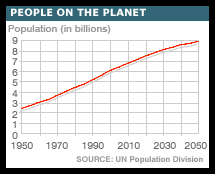
The Population Explosion.
|
The human population continues to grow at an astonishing rate but cannot grow without food for sustenance. All of the globe's most productive land is already under cultivation and the great boost of agricultural productivity has already taken place though the use of "miracle" seeds and fertilizers.
How long can population and industrialization continue to grow on this finite planet?
The question has been asked for many years. The political will to address the problem in any meaningful world wide way is lacking.
|
|
"The Limits to Growth" report.
How long can population and industrialization continue to grow on this finite planet? The question was asked in 1970 by the seventy eminently respectable members of the Club of Rome who sponsored an international team of scientists led by 29 year old M.I.T. computer specialist Dennis Meadows to simulate the major ecological forces at work in the world using the finest computer facility of the day.
The team's study was called "The Limits to Growth" and at the time it created a great stir and much debate. The authors of the study proposed that a world wide all out effort of equalizing the birth and death rates starting before 1975 would be required to stabilize population.
The environment section of Time magazine covered the report in the 24 January 1972 issue and at that time I clipped this chart and pinned it up on my cork board - it has been there ever since!
 From Time magazine 24 January 1972
From Time magazine 24 January 1972
|
|
Twenty years later the Meadows team assembled once again and in 1992 published an updated report to review the changes that had taken place.
|
|
Moving forward a few years from 1972 - the following appeared in the Toronto Globe & Mail in the issue of 24 October 1988:
|
Coping with a population explosion.
In 1986, Kenya had a population of 21 million. In the year 2000, it will have 36 million. Kenya is a relatively poor country; in the space of 14 years it will have given itself almost twice as many people to house, clothe and feed. It will have to run furiously even to stand still.
We single out Kenya as an illustration, not an exception. The population figures in the World Bank's 1988 World Development Report speak volumes about the task the world will have in grappling with debt relief and the roots of hunger, disease and deforestation. Take Ethiopia, Burkina Faso, Bangladesh, India, Uganda, Tanzania, Nigeria - all their populations will have grown by 50 per cent in those 14 years.
Yet it is not a subject governments talk about when negotiating for debt relief. Creditors and debtors alike ignore it for the most part, unable or unwilling to grapple with the urgency of family planning. And as they avert their eyes, the problem grows steadily worse.
China is one of the few countries to take seriously the dangers of unchecked population growth and to launch an effective campaign against it. If there were Draconian excesses in the early days of that campaign, since mercifully relaxed, the one child policy remains an important investment in the country's future. And let there be no doubt that the Chinese value children as much as the people of any other country; there is no contradiction in using birth control to assure the quality of their children's lives.
The results will be dramatic. "As a result of the one-child policy," the report said, "the school-age population will fall during the next 50 years not only as a proportion of the total population but in absolute size as well." (By contrast, the school-age populations in Kenya and Rwanda will double by 2000.) Pressures for social spending will ease in the next decade as dependency ratios fall, and China can emphasize improving the quality of services and access to them. Only well into the next century will the dependency ratio increase from today's levels, as current and future workers reach old age."
Even if debt relief helps to give the poorest countries more room to spend on their people, those countries will have to spread their resources more thinly as more people make demands on them. This applies to more than the impoverished countries. Mexico, defined as having an upper-middle income, will see its population rise from 80 million to 107 million between 1984 and 2000. Brazil's population will rise from 138 million to 180 million.
There are many obstacles in the crusade for family planning. Illiteracy makes it hard to reach significant numbers of people in some countries. The Catholic Church's stand against many forms of birth control deters many followers from using reliable methods. There may be other religious barriers, or cultural barriers, or a desire to hedge against the possibility that one or more children might die. This is far from a simple issue.
But its consequences may be simply expressed. The control of population growth, the World Bank wrote in its 1987 report, "is crucial in the long run for the alleviation of poverty... Without this, whatever progress is made through structural adjustment in terms of income growth could be annihilated."
An explosion of births is one problem among many - regional tensions, environmental degradation, inadequate networks for distributing food - but it touches almost all the others. It can't be ignored.
|
"Save the Earth"
"Save the Earth" by Jonathon Porritt was published in 1991 and presented the same conclusion as "The Limits to Growth" report regarding the population explosion, referring to it as the "Time Bomb of Overpopulation".
The book leaves one with the clear understanding that although there are many threats to the environment and Earth itself, ultimately there is really only one root cause of environmental degradation and that is humankind - everything else is, in one way or another, secondary.
|

|
 Editorial cartoon May 1998
Editorial cartoon May 1998
|
And a couple more notes from May 1998:
The Futurist magazine reports: "A team of researchers at the University of British Columbia recently estimated that the typical North American consumes resources each year equivalent to the renewable yield from 12 acres of farmland and forest land. For all the world's people to consume at this rate is a mathematical impossibility. It would require four Earths' worth of production. In other words, we're three planets short."
"In the next 25 years," says the World Health Organization, "the population aged 65 and above is likely to grow by 88 per cent -- almost a million people a month -- compared with an increase of 45 per cent in the working age population."
Check this graph from 2002 with the "Projection for Disaster" chart above:

|
Update: September 2004 from the BBC: http://news.bbc.co.uk/2/hi/in_depth/3658258.stm
UN warns of population explosion
The population of developing countries will soar unless donors give more funds to reproductive health programmes, a UN Population Fund report says.
The world's 50 poorest countries will triple in size by 2050, surging to 1.7 billion people, it predicts.
Donors have been giving only half the funds pledged at a conference in Cairo in 1994, UNFPA told BBC News Online.
The money is used for programmes supporting women's rights and health care in the developing world.
UNFPA's State of the World Population 2004 report examines progress made since Cairo, when wealthy countries pledged to give an annual $6.1bn to the fund.
William Ryan, the report's author, told BBC News Online that although developing countries were making great strides to tackle the problems of a growing population, the fund was $3bn short.
"Without access to health services and education the population will continue to increase, above all in the poorest countries," he said.

US holds back
By 2050, UNFPA says, there will be 8.9 billion people sharing the planet, a slight decrease from earlier official predictions.
The US - the fund's largest donor - has blocked its donations to the body for the past three years.
The Bush administration froze $34m in funding, citing allegations that the UNFPA was involved in forced abortions in China - a charge consistently denied by the organization.
"We note that with an additional $34m we could help provide family planning to thousands of women who need it," Mr Ryan said.
Aids impact
In addition to the threat of overpopulation, half a million women now die annually during childbirth in the developing world.
The fund says gaps in reproductive health care - a lack of access to information, care and practical resources like contraceptives - accounts for nearly 20% of the worldwide burden of illness and premature death.
Providing contraception for the 200 million women who want it, at a cost of $3.9bn, would avert some 52 million pregnancies each year and avoid 1.4 million infant deaths, it says.
Aids has also affected the changes in population size, the report says - the 38 African countries most affected by Aids are projected to have 823 million people in 2015.
The figure is 91 million fewer than if no Aids deaths had occurred but over 50% more than today.
|

| The "Holmestead" is located at: |
| 140 Thunder Beach Road, 17th Concession, Township of Tiny, |
| ONTARIO, L9M 0T3, CANADA |
|



